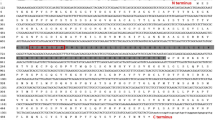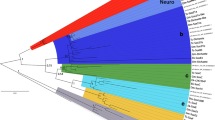Abstract
Sox genes share a highly conserved DNA-binding motif, the HMG (high mobility group)-box domain, and have diverse roles in vertebrate embryonic development. A novel SRY-related cDNA (temporarily called Sox33) isolated from the Chinese alligator (Alligator sinensis) is 1,819 bp in length, with an open reading frame from 220 to 1113 bp, encoding a protein of 298 amino acids. Two putative polyadenylation signal sequences (AATAAA) are present upstream of the poly(A) tail in the 3′ UTR (at 1255–1260 and 1774–1779). The putative protein contains an HMG-box domain most closely related to hSox12, mSox4, rtSox11, and mSox11 homologs, indicating that alligator Sox33 belongs to group C in the Sox gene family. Alligator adult and developing tissues were tested for Sox33 mRNA by independent Northern blots using a 336-bp probe (at 907–1243) between the HMG-box and the poly(A) site I and a 277-bp probe (at 1477–1754) between the two polyadenylation sites. Two transcripts (1.3 kb and 1.8 kb) in developing brain and one (1.8 kb) in adult brain were identified by the 336-bp probe; only one transcript (1.8 kb) in developing and adult brains was detected by the 277-bp probe. The results suggest that alligator Sox33 may use a different polyadenylation mechanism in the developing brain and play a role in the development and maintenance of the nervous system.



Similar content being viewed by others
References
Bowles J, Schepers G, Koopman P (2000) Phylogeny of the SOX family of developmental transcription factors based on sequence and structural indicators. Dev Biol 227:239
Cheung M, Abu-Elmagd M, Clevers H, Scotting PJ (2000) Roles of Sox4 in central nervous system development. Mol Brain Res 79:180
Collignon J, Socknathan S, Hacker A, Cohen-Tannoudji ND, Rastan S, Stevanovic M, Goodfellow PN, Lovell-Badge R (1996) A comparison of the properties of Sox3 with Sry and two related genes Sox1 and Sox2. Development 122:509
Fowlkes JL, Thrailkill KM, George-Nascimento C, Rosenberg CK, Serra DM (1997) Heparin-binding, highly basic regions within the thyroglobulin type-1 repeat of insulin-like growth factor (IGF)-binding proteins (IGFBPs)-3, -5, and -6 inhibit IGFBP-4 degradation. Endocrinology 138:2280
Gubbay J, Collignon J, Koopman P, Capel B, Economou A, Munsterbery A, Vivian N, Goodfellow PN, Lovell-Badge R (1990) A gene mapping to the sex-determining region of the mouse Y chromosome is a member of a novel family of embryonically expressed genes. Nature 46:245
Hargrave M, Wright E, Kun J, Emery J, Cooper L, Koopman P (1997) Expression of the Sox11 gene in mouse embryos suggests roles in neuronal maturation and epithelio-mesenchymal induction. Dev Dyn 210:79
Hua TM, Wang CL, Chen BH (2004) Stages of embryonic development for Alligator sinensis. Zool Res 25:263 (In Chinese)
Jay P, Sahly I, Goze C, Taviaux S, Poult F, Couly F, Abitol M, Berta P (1997) Sox22 is a new member of the Sox gene family, mainly expressed in the human nervous tissue. Hum Mol Genet 6:1069
Kanda H, Kojima M, Miyamoto N, Ito M, Takamatsu N, Yamashita S, Shiba T (1998) Rainbow trout Sox11, a novel member of the Sox family, is a transcriptional regulator during oogenesis. Gene 211:251
Katoh K, Miyata T (1999) A heuristic approach of maximum likelihood method for inferring phylogenetic tree and an application to the mammalian Sox3 origin of the testis-determining gene SRY. FEBS Lett 463:129
Pevny LH, Lovell-Badge R (1997) Sox gene find their feet. Curr Opin Genet Dev 7:338
Sambrook J, Russell DW (2002) Molecular cloning: a laboratory manual, 3rd edn. Cold Spring Harbor Laboratory, Cold Spring Harbor, NY
Schepers GE, Teasdale RD, Koopman P (2002) Twenty pairs of Sox: extent, homology, and nomenclature of the mouse and human Sox transcription factor gene families. Dev Cell 3:167
St. Johnston D (1995) The intracellular localization of messenger RNAs. Cell 81:161
Uwanogho D, Rex M, Cartwright EJ, Pearl G, Healy C, Scotting PJ, Sharp PT (1995) Embryonic expression of the chicken Sox2, Sox3 and Sox11 genes suggests an interactive role in neuronal development. Mech Dev 45:23
Zheng JF, Zhu MY (2006) Isolation and sequence analysis of the Sox-1, -2, -3 homologs in Trionyx sinensis and Alligator sinensis having temperature-dependent sex determination. Biochem Genet 44:98
Acknowledgments
We would like to acknowledge the staff of the Research Center for Chinese Alligator Reproduction in China for providing the experimental material, and the staff of Shanghai Biolink Informatics Inc. for expert technical assistance. This work was supported by the Natural Science Foundation of Hunan Province (Grant No. 04JJ40021) and the Scientific Research Foundation for Doctor in Nanhua University (Grant No. 5-03-XJQ-03-044).
Author information
Authors and Affiliations
Corresponding author
Rights and permissions
About this article
Cite this article
Zheng, J., Hu, N., Zhu, M. et al. Isolation and Expression of a Novel Alligator Gene Belonging to the Sox Gene Family. Biochem Genet 47, 137–146 (2009). https://doi.org/10.1007/s10528-008-9213-3
Received:
Accepted:
Published:
Issue Date:
DOI: https://doi.org/10.1007/s10528-008-9213-3




